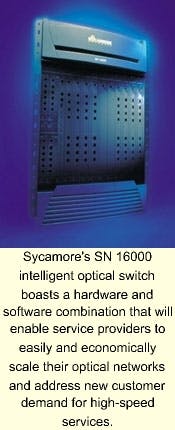Sycamore calls SN 16000 'next step' for intelligent optical networks
Sycamore is touting its new switch as a means to nondisruptively scale a network "just in time," allowing carriers to start small and expand their infrastructures inline with customer demands. According to iaxis, a European carriers' carrier that will conduct field trials of the SN 16000 in France and Germany in the first quarter of 2000, Sycamore's focus is what sets them apart. The company is not simply focused on supplying more bandwidth but providing the tools that make that same bandwidth work smarter.
"On this switch, we've really focused on the software-centric architecture," says Jeff Kiel, vice president of product marketing at Sycamore. "We've invested heavily in the software because we view switching as a software problem that has to be solved."
At the heart of the SN 16000 architecture is its intelligent software platform that Sycamore says will make the end-to-end provisioning and restoration of high-speed, on-demand services economical and efficient. Software for managing the wavelengths is the key, particularly in the areas of provisioning, restoration, grooming, and protection. Sycamore has provided flexibility in provisioning and added intelligence to allow service providers to migrate their networks away from what the company describes as "rigid and maintenance-intensive ring-based architectures to a more efficient mesh configuration." For instance, grooming becomes more of an optional feature.
"We don't believe in putting grooming everywhere because it involves electronics," says Kiel. "Wher ever you put electronics, it will cost money. So you only want to put it in places where you need it, and view it as a precious resource. The software will be able to track where these grooming resources are and will be able to manage them in the most efficient way possible."
The SN 16000 is designed to be scalable from 64x64 to 512x512 to 1024x1024 and the first product release is planned to go as high as 512x512. Although it will eventually be available to accommodate speeds from OC-3 through OC-192, the first release will support up to OC-48 (2.5 Gbits/sec) with OC-192 available by the end of 2000. Upgrades can be achieved without disrupting services, both from a hardware and software perspective.
The switch uses industry-standard protocols for routing and signaling to enable interoperability with other systems. Multiprotocol label switching (MPLS) is the signaling protocol, popular with today's IP systems. MPLS, along with Sycamore's use of the open shortest path first standard provides a means of interoperability in hybrid optical/electrical environments. Sycamore believes this design will facilitate industry-wide interconnection between higher-level service and optical domains for the creation and management of high-speed wave services.
Rather than using electrical-based interconnect between cards and shelves, Sycamore opted for optical interconnect using 850-nm vertical-cavity surface-emitting lasers (VSCELs). "That way, you're not capped at the highest speed as with electrical interconnection," says Kiel. "With optical interconnection, you can continue to grow this switch as newer technology becomes available or through additional shelves with additional capacity. It's a 'pay-as-you-grow' concept, so you can start from the smallest configuration and move through the larger and larger configurations. Also, from a software perspective, we're using Internet-protocol routing and signaling methods to scale the network."
Is the SN 16000 a truly all-optical switch? No, but Sycamore feels it is still debatable whether purely all-optical switching technology has overcome hurdles such as the ability to be efficiently deployed into existing network environments and incorporate system software to support scaling, provisioning, and rerouting.
"The key is having a deployment-ready optical-switching technology," says Kiel. "That's why we made the choice of the VSCEL technology for the optical backplane. This allows us to scale the matrix and puts us in a position to--when it makes business and economic sense--to start to replace the electronics and take it to a more and more optical switch. From our perspective, optical technology is only valuable if it provides performance, scaling, and cost benefits over electrical technology. So we believe we struck the right balance where technology exists today."
"The name of the game is scalability and software," says Dana Cooperson, a senior analyst with RHK, a San Francisco-based industry research and consulting firm. "Sycamore does seem to have done its homework in both those areas, but it really does remain to be seen once [the SN 16000] is out there in a real network environment. Traditionally, Sycamore tends to wait until they're pretty much ready to release before they make any announcement...and that's always a real differentiator. That in itself lends some credence to what they're doing."
"The need for these types of products in the marketplace is just beginning to manifest itself, so the market timing is very good. Along with other products they've announced, it adds on to a pretty complete platform," adds Cooperson.
The SN 16000 is the latest addition to a family of Sycamore products aimed at delivering all the components necessary to create an intelligent optical network. It joins two previously announced transport products, the SN 16000 and the SN 8000. The SN 16000 is a long-haul transport product geared for point-to-point applications over existing infrastructures. It can not stand alone but is essentially an adaptation product for a carrier with an in-place network that's ready to begin a migration process. By comparison, the SN 8000, announced last November, is a stand-alone transport product that can be used throughout the entire network.

